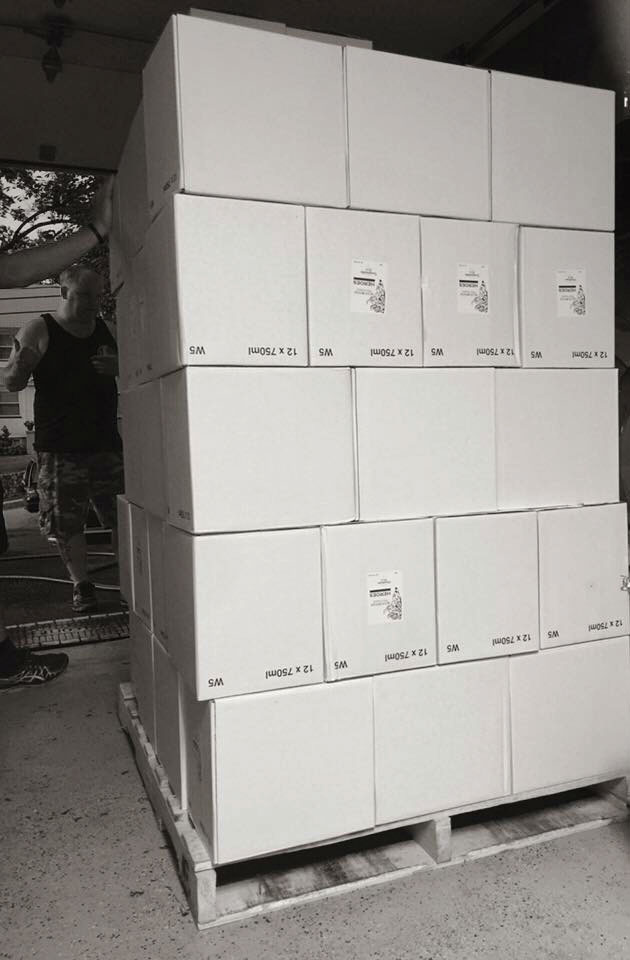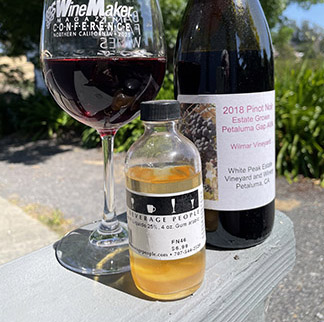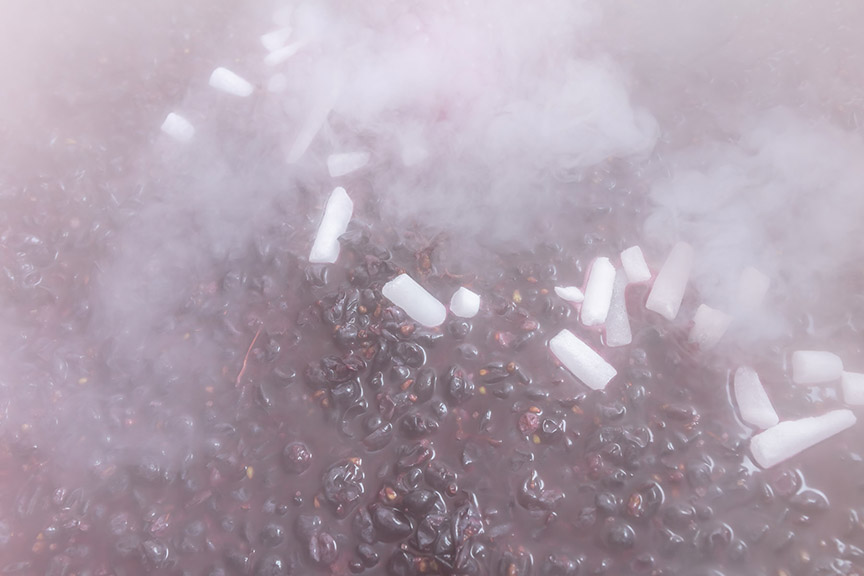Growing Pains: Aging and packaging big batches
If you make your wine in one or just a few 5- or 6-gallon (19- or 23-L) carboys, “bulk” aging is not a big problem. As they rest for a few months, those carboys can be under a workbench in the garage, inside a little-used closet, or even under the kitchen sink. When it comes time to bottle, you can lift the carboy onto a countertop and bottle by gravity using a racking cane and bottle filler wand.

Many home winemakers have bigger dreams, though. Some are even building their skills and experience toward going pro and moving from a few cases per year to a thousand or more. They may want to see the family name on the labels and send wine out to buyers all over the country. If you find yourself moving up from 5 gallons (19 L) toward 200 gallons (760 L), everything about your hobby is likely to change. At that U.S. legal limit for home winemaking (with two or more adults in the household), you will find yourself bulk-aging a volume greater than three standard wine barrels and bottling on the order of 1,000 bottles or 84 cases. The storage space under the sink won’t work anymore and a spare closet is not going to act as a case-goods wine cellar.
Beyond using makeshift space around the house or garage for a carboy or two, you will need to address facility requirements when you move into a mid-range production of perhaps 50 gallons (189 L) per year. A major consideration is that you need to leave aging containers in place for at least a few months for white wines and up to a year or more for reds. That 50+ gallons (189+ L) may represent ten 5-gallon (19-L) or eight 6-gallon (23-L) carboys, four 14-gallon (53-L) demijohns, or one or two barrels in the 30- to 60-gallon (114- to 227-L) range. Even in the garage, that kind of months-long storage will get in your way if you don’t have a dedicated space. A small room partitioned off in a garage or basement or a small freestanding shed or outbuilding is ideal at about this size of winery for storage and then bottling. If you move up toward the maximum legal limit or contemplate going pro, you will need more space than that. A large room and entire garage, or a medium-size outbuilding is going to be needed. My own wine building at 13 ft. x 17 ft. (4 m x 5 m) easily accommodates my usual annual production of about 60 to 100 gallons (227 to 379 L).
Some years, though, my wife and I have purchased enough grapes and brought in a good enough crop in the home vineyard to go over that level and then I find the space crowded and less efficient to work in. For instance, the room that is my year-round cooled wine cellar is 5 ft. x 9 ft. (1.5 m x 2.7 m) and has 1-ft. (0.3-m) deep wine racks along both long walls. The floor of the aisle that is left in the middle can accept two of the 1-hectoliter (100-L, 26-gallon) barrels that I use when barrel aging. If I need to use my third barrel, and for any carboys and demijohns of additional wine, I have to put those outside of the 55 °F (13 °C) temperature-controlled room. My typical solution is to put inert vessels (glass or PET plastic) in the adjacent room, store them through the winter, and then bottle in the spring before weather in my area warms up too much. Having one wall shared with the cooled space — and with heavy insulation — the room stays reasonably cool and constant, but it is less desirable than a true temperature-controlled space like found in my wine cellar. It is not too often that you will run into a winemaker complaining about having too much space in their winery.
The storage space under the sink won’t work anymore and a spare closet is not going to act as a case-goods wine cellar.
When it comes time to bottle your wine, larger volumes make further demands on your facilities. While the bulk wine to be bottled is occupying its space, you need to have enough room nearby to rack it one more time off of the final sediment before you bottle. If you are going to filter, you need that space as well. While I have had no problem coming up with those spaces in my little winery, I was surprised by another demand the first time I made more wine than usual: I needed twice the bottle space. That is, after identifying a space to stack the filled cases, I realized I needed an equal space for the cases of empty bottles just before filling. I typically buy new bottles rather than reusing, so I wait until just before my bottling date to bring them home. I prefer to stack them in the third room of my winery, but if I am short on space I will stack them temporarily outside in the shade — I don’t want to fill my wine into warm bottles. So keep in mind that on bottling day the bulk wine has to go from here to there, and the cases of bottles do, too.
Equipment needs in this arena step up with winery size also. At mid-range and larger you will probably need a pump to move your wine in bulk storage. I can easily move my hectoliter barrels by hand when empty, but not when they are full. That means that when I rack the wine during aging, I pump it into my 200-L (53-gal.) stainless steel tank. After rinsing the barrel, it is time for the pump again to move the wine back for further aging. While you can lift up a carboy or even a demijohn to bottle by gravity, that isn’t easy with a barrel. One solution I have found for bottling larger batches is to place my empty tank on a hydraulic ATV lift, like those sold for lifting ATVs or motorcycles for service or oil changes. I can pump from a barrel or carboys into the tank in the lowered position then raise it up about 19 inches (0.48 m) to fill bottles by gravity on the floor. With a 1,500-lb. (680-kg) capacity, the lift more than handles the 200-L (53-gal.) tank that would weigh just over 450 lbs. (200 kg) completely full. Other alternatives include using a bottling system with a built-in pump, pumping up to a PET carboy on a raised platform and bottling out of that by gravity, or using a combined vacuum-driven filter and bottler. One way or another, some mechanical equipment is going to be needed.
Cellaring supplies are typically not very bulky and you probably won’t notice much change up to about 200 gallons (760 L). Sulfite additions, finishing tannins, or backsweetening sugars will still be in compact packages. Corks take up a bit more space, but you are still only dealing with grocery-bag size quantities. The bottles themselves, though, are another matter. At 200 gal. (760 L), you need just over 1,000 750-mL bottles or about 84 cases. Since wine bottles are handled at wholesale in pallets of about 90 cases, you can envision the size of bottle handling capability you will need. If you live in an area with commercial wineries, your local home winemaking supplier may deal in pallets of bottles and you might find it cheaper to buy a full pallet rather than by the case. Of course, you need to arrive at the store with a vehicle or trailer that can carry that many bottles home. Easiest is either a pickup truck with sufficient width between the wheel wells for a pallet or a low-bed utility trailer. The pallet will probably be wrapped in plastic, but be prepared to strap or tie it securely so you don’t lose any cases on the drive home.
If you don’t live in such an area and want to use new, matching bottles for your wine, you additionally face shipping costs. It can be quite expensive to ship bottles in quantities of 20 or 30 cases and you may find it economical to order a full pallet to be shipped by truck. If you do that, keep in mind that you need a way to unload the shipment when it gets to your home winery. If you do not have a forklift (or a forklift attachment for your tractor), try to arrange for the delivery truck to come equipped with a lift gate so you can at least get your pallet of bottles set down in your driveway. From there, a pallet jack is useful for moving the bottles to your bottling space, providing your pavement is smooth and level enough for such a device. If not, you will need to unstick the pallet in the driveway and move a few cases at a time with a dolly or cart. If you instead wash and reuse bottles, make sure you have planned enough space in your winery to accumulate a pallet’s worth of cases if you want to bottle in those volumes.
Finally, consider your labor needs. Throughout the aging period, you probably won’t need much help. Adding sulfites is easy. Racking with a pump is a bit trickier and I like to have one helper for that. You want to control both ends of your hose setup and still be able to turn the pump on and off. For bottling just a carboy or two, you can easily do it yourself in a fairly short time. When you get up to barrel-size batches, you can make very good use of a helper or two. My preferred bottling crew is three or four people: Two filling by gravity and the third, and possibly fourth, corking the bottles and moving the cases. It’s hard work, but dozens of cases can be filled in less than half a day. Then treat your crew to a nice lunch out while your new wine begins working its way through bottle shock.






